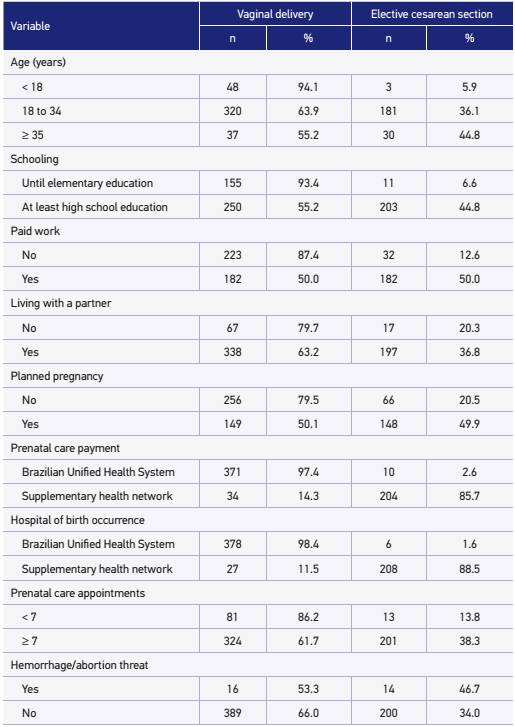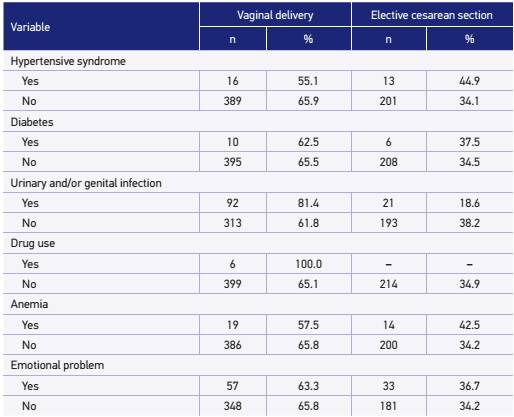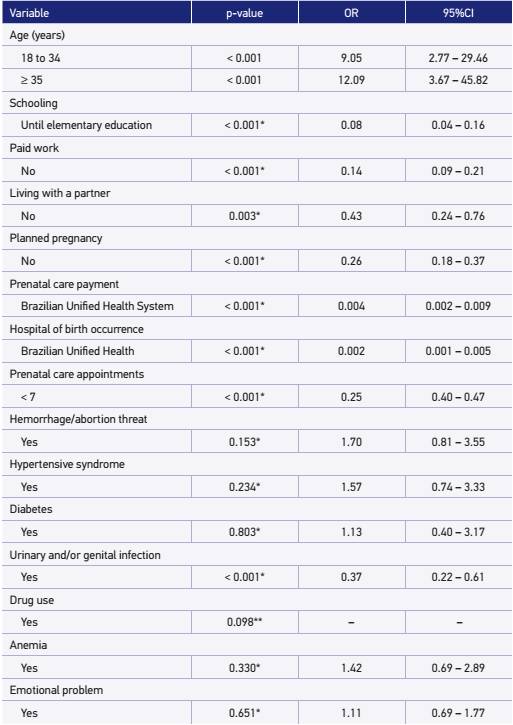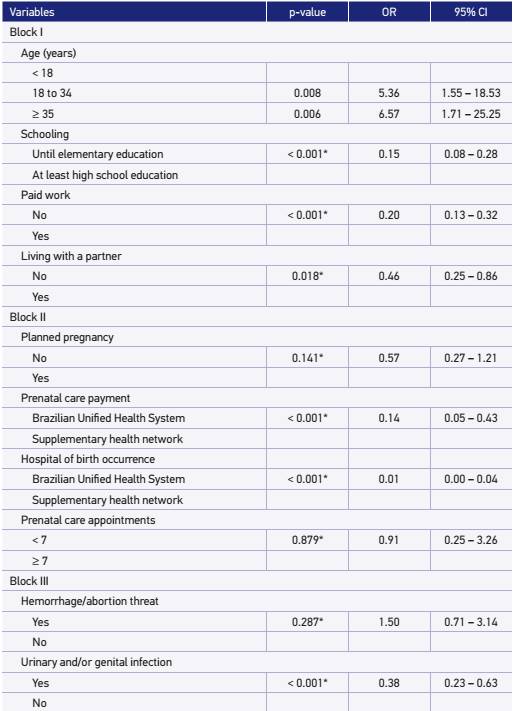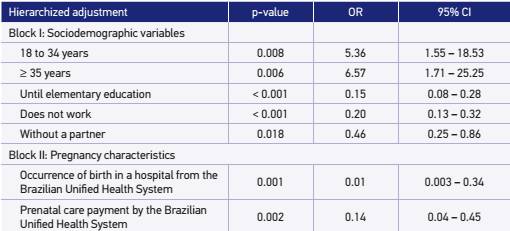ABSTRACT:
Objective:
To identify socio-demographic factors, characteristics and pregnancy complications associated with elective cesarean section.
Methods:
Cross-sectional study. A total of 1,295 births in the first semester of 2012 in Botucatu, São Paulo, Brazil, were evaluated in a large epidemiological study of maternal and child morbidity and mortality. This article compares women who had normal births (n = 405) with 214 undergoing elective cesarean section, defined as scheduled and without reference in hospital records or prenatal card of absolute, relative indication or any medical reason for that. Data were obtained from hospital records, prenatal card and interview with women, soon after parturition. Univariate analysis was conducted and evaluated by Fisher's exact or χ2 tests. Variables with p < 0.20 were grouped into three blocks and, by hierarchical multiple logistic regression model, the associated factors with elective cesarean section were identified, considering p < 0.05.
Results:
Socio-demographic variables (age ≥ 18 years, ≥ high school education, paid work and living with a partner) were independently associated with increased odds of elective cesarean section. Regardless of these, there was an association between elective caesarean section and prenatal and place of birth, with a higher chance of birth by elective caesarean section when the woman was assisted by the supplementary health network. Taking as indicators of unfavorable socioeconomic conditions the low education, the payment of prenatal and childbirth by the Unified Health System, it can be said that there was an association between elective caesarean section and better socio-economic conditions.
Conclusion:
Actions in the supplementary health network are required to approach the cesarean delivery rate in the municipality to the international recommendations.
Keywords:
Prenatal care; Parturition; Cesarean section; Pathology; Social conditions; Pregnant women.
INTRODUCTION
Rede Cegonha is the main Brazilian public policy for maternal-child health care and is based on the assurance of care with quality, safety, and humanization since family planning, prenatal care, delivery, and puerperium until the second year of a baby's life. Its guidelines include the indication for health services to adopt measures and procedures that are widely known as advantageous and safe to monitor parturition and birth, avoiding unnecessary interventionist practices11. Brasil. Ministério da Saúde. Conheça a Rede Cegonha [Internet]. Brasília (DF): Ministério da Saúde; 2013. Disponível em: Disponível em: http://bvsms.saude.gov.br/bvs/folder/rede_cegonha.pdf (Acessado em: 4 de agosto de 2014).
http://bvsms.saude.gov.br/bvs/folder/red... .
In order these guidelines can be achieved, it is essential that women take part in the parturition process actively and, thus, they should be informed about their health rights in general and specially in the puerperal pregnancy cycle. The lack of information and/or acknowledgment of mistaken information contribute in such a way that the pregnant woman does not know about the advantages of vaginal delivery compared with the cesarean delivery, when there is no indication for the performance of surgical delivery22. Souza JP, Gülmezoglu AM, Lumbiganon P, Laopaiboon M, Carroli G, Fawole B, et al. Caesarean section without medical indications is associated with an increased risk of adverse short-term maternal outcomes: the 2004-2008 WHO Global Survey on Maternal and Perinatal Health. BMC Med 2010; 8: 71-81..
The vaginal delivery facilitates the early contact between the mother and the baby; enables a better maternal recovery; allows the pulmonary compression of the newborn through delivery, resulting in a lower occurrence of respiratory discomfort; contributes to low infection levels, postpartum hemorrhage, and maternal death; and results in lower costs, as it does not use surgical procedures. Therefore, its benefits are directed both to the mother and to the child33. Costa AP, Bustorff LACV, Cunha ARR, Soares MCS, Araújo VS. Contribuições do pré-natal para o parto vaginal: percepções de puérperas. Rev Rene 2011; 12(3): 548-54..
The cesarean surgery is associated with higher maternal predisposal to complications such as hemorrhages, infections, and possibilities of accidental laceration of some internal organs, resulting in high risk of maternal morbidity and mortality44. Mandarino NR, Chein MBC, Monteiro Júnior FC, Brito LMO, Lamy ZC, Nina VJS, et al. Aspectos relacionados à escolha do tipo de parto: um estudo comparativo entre uma maternidade pública e outra privada, em São Luis, Maranhão, Brasil. Cad Saúde Pública 2009; 25(7): 1587-96.. At medium and long terms, there is an association between cesarean section and early weaning, atopic conditions, and deviations of child growth55. Prior E, Santhakumaran S, Philipps LH, Modi N, Hyde MJ. Breastfeeding after cesarean delivery: a systematic review and meta-analysis of world literature. Am J Clin Nutr 2012; 95(5): 1113-35.,66. Renz-Polster H, David MR, Buist AS, Vollmer WM, O'Connor EA, Frazier EA, et al. Caesarean section delivery and the risk of allergic disorders in childhood. Clin Exp Allergy 2005; 35(11): 1466-72.,77. Spyrides MHC, Struchiner CJ, Barbosa MTS, Kac G. Efeito da duração da amamentação predominante no crescimento infantil: um estudo prospectivo com modelos não lineares de efeitos mistos. J Pediatr 2008; 84(3): 237-43., besides negative repercussions for the sexual and reproductive health of these women22. Souza JP, Gülmezoglu AM, Lumbiganon P, Laopaiboon M, Carroli G, Fawole B, et al. Caesarean section without medical indications is associated with an increased risk of adverse short-term maternal outcomes: the 2004-2008 WHO Global Survey on Maternal and Perinatal Health. BMC Med 2010; 8: 71-81..
According to a study of national basis that was recently published in some Brazilian states like São Paulo, the cesarean section rate overcomes 40%, and in private services, it reaches 88%. This fact places Brazil among the countries with the highest rates of cesarean section, with 52% of the total parturitions in the country takes place through this surgery88. Domingues RMSM, Dias MAB, Nakamura-Pereira M, Torres JA, d'Orsi E, Pereira APE, et al. Processo de decisão pelo tipo de parto no Brasil: da preferência inicial das mulheres à via de parto final. Cad Saúde Pública 2014; 30(Suppl 1): S101-6., which is very distant from the rate presented as acceptable for decades by the World Health Organization: 10 to 15%99. World Health Organization. Appropriate technology for birth. Lancet 1985; 2(8452): 436-7..
Thus, by considering the basis of the pregnancy resolution place, there is a consensus that the highest cesarean rates are found in the private/funded hospitals, whereas the highest rates of vaginal delivery are seen in hospitals from the Brazilian Unified Health System (SUS). The excess rate of cesarean sections indicates that an expressive amount of these surgeries are elective, that is, previously scheduled and performed before the beginning of labor, even on low-risk pregnant women, and without acceptable indication for pregnancy interruption1010. Tita AT, Landon MB, Spong CY, Lai Y, Leveno KJ, Varner MW, et al. Timing of elective repeat cesarean delivery at term and neonatal outcomes. N Engl J Med 2009; 360(2): 111-20..
Studies that assessed the determiners of high rates of cesarean sections, in general, do not separate elective cesarean sections from those with indications. In the international context, investigations have discussed some aspects such as the relation between cesarean section rate and better socioeconomic condition1111. Ronsmans C, Holtz S, Stanton C. Socioeconomic differentials in caesarean rates in developing countries: a retrospective analysis. Lancet 2006; 368(9546): 1516-23., the maternal "preference" for cesarean section1212. Karlström A, Nystedt A, Johansson M, Hildingsson I. Behind the myth: few women prefer caesarean section in the absence of medical or obstetrical factors. Midwifery 2011; 27(5): 620-7., the women's autonomy to decide on her own delivery, like a value or right1313. Demontis R, Pisu S, Pintor M, D'aloja E. Cesarean section without clinical indication versus vaginal delivery as a paradigmatic model in the discourse of medical setting decisions. J Matern Fetal Neonatal Med 2011; 24(12): 1470-5., medical and ethical aspects of requested cesarean section1414. Kalish RB, McCullough LB, Chervenak FA. Patient choice cesarean delivery: ethical issues. Curr Opin Obstet Gynecol 2008; 20(2): 116-9., and iniquities in using this kind of delivery1515. Gibbons L, Belizan JM, Lauer JA, Betran AP, Merialdi M, Althabe F. Inequities in the use of cesarean section deliveries in the world. Am J Obstet Gynecol 2012; 206(4): 331.e1-19..
In Brazil, a study developed in the South was carried out to identify social inequalities in complications after cesarean surgery, and identified complications two times more frequent after cesarean section, regardless the socioeconomic conditions1616. Freitas PF, Savi EP. Desigualdades sociais nas complicações da cesariana: uma análise hierarquizada. Cad Saúde Pública 2011; 27(10): 2009-20.. After the authors compared two studies, the first one in the years of 1978/1979 and the second one in 1994, conducted in the city of Ribeirão Preto, São Paulo, which included live newborns of a single hospital delivery, they attributed cesarean sections to the increase in rates of low weight at birth, with emphasis on the fact that they probably were elective interventions1717. Bettiol H, Rona RJ, Chinn S, Goldani M, Barbieri MA. Factors associated with preterm births in southeast Brazil: a comparison of two birth cohorts born 15 years apart. Paediatr Perinat Epidemiol2000; 14(1): 30-8..
Because of the lack of studies approaching this kind of delivery in the country, this study aims at contributing to the knowledge about the determiners of high rates of cesarean sections in Brazil, especially when there is not an accurate indication for its performance. The introduced originality refers to the approach of this intervention not only in general, but also considering the elective surgery as opposed to the vaginal delivery. The objective is to identify sociodemographic factors, pregnancy characteristics, and complications associated with the specific performance of elective cesarean section.
METHODS
This is a cross-sectional study constituting a larger investigation called "O binômio mãe-filho em Botucatu: estudo epidemiológico com ênfase na morbimortalidade maternal e infantil " [The mother-child pair in Botucatu, Brazil: epidemiological study with emphasis on maternal and child morbidity and mortality], whose data were collected in maternities from two hospitals in this city: a public and one from the supplementary health network.
The public hospital works almost exclusively for SUS. Its maternity has 40 obstetric beds to care for low-risk deliveries of the main city and it is a reference for the care of pregnant women and newborns who are at risk in 30 cities from the region of Pólos Cuesta and Vale do Jurumirim. The hospital maternity that belongs to the supplementary health network counts on 16 obstetric beds that are directed only to private care and to pregnant women with health insurance.
Data collection took place from January to June 2012 and was performed by trained and paid staff. In this period, 1,395 births happened in Botucatu. The original study included 1,317 puerperal women (94.4%), and this difference was due to the loss of patient contact before their hospital discharge (n = 71) or refusal (n = 7). Twenty-two cases of multifetal pregnancies were excluded; 1,295 cases were available for relative analyses at birth: 923 (71.3%) from the public maternity and 372 (28.7%) from the supplementary health network maternity.
The elective cesarean section was defined as: cesarean referred by the woman as scheduled and without reference in the hospital record or prenatal care card for absolute or relative indication1818. Amorim MMR, Souza ASR, Porto AMF. Indicações de cesarianas baseadas em evidências: parte I. Femina 2010; 30(8): 417-22. or for any other medical reason. Cesarean cases with indication in both maternities (n = 676) were then excluded, and the sample of this study included 619 births, of which 405 were through vaginal delivery and 214 through elective cesarean section.
The dependent variable was the kind of delivery: elective cesarean section or vaginal delivery. Based on the hierarchized multiple logistic regression model, constituted of three blocks (Figure 1), we found that the factors independently associated with elective cesarean section.
The sociodemographic factors comprised the block I independent variables: age (< 18, 18 to 34, ≥ 35 years); schooling (until elementary education, at least high school); paid work (no, yes); and living with a partner (no, yes). Block II included the variables associated with pregnancy characteristics: planned pregnancy (no, yes); kind of prenatal care payment (SUS, supplementary health network); kind of hospital where the birth happened (SUS, supplementary health network); and number of prenatal care appointments (< 7, ≥ 7). Block III included variables regarding pregnancy complications: hemorrhage or abortion threat during pregnancy (yes, no), hypertensive syndrome, diabetes, urinary and/or vaginal infection, drug use, anemia, and emotional problem.
Data that constitute the block I variables were collected from the prenatal care card (age and schooling) and through interview (paid work and living with a partner). Block II data were collected through interview (planned pregnancy), prenatal care card (kind of prenatal care payment and number of prenatal care appointments), and medical record (kind of hospital where the birth happened). The third-block variables were collected in the prenatal care card.
Initially, the univariate analysis was performed with all variables of each hierarchical level, in which the gross odds ratios (OR) were estimated with 95% confidence interval (95%CI). Variables with statistical significance level > 0.20 were removed. Posteriorly, models were used for the variables of each level by identifying those associated with elective cesarean section in the level of p < 0.05. Then, a multiple and hierarchized model was created and adjusted for the variables from the former blocks. Hence, such model did not consider the risk factors that have a higher position as exercising its actions through those located in a lower position.
This study was approved by the Ethics Committee in Research of Botucatu School of Medicine, under process number 245/2012.
RESULTS
Most of the women were aged 18 years or older (568/619; 91.8%), and 10.8% (67/619) of them were 35 years or older, 73.2% (453/619) had completed at least high school education, 86.4% (535/619) lived with a partner, and 84.8% (525/619) had gone to seven or more prenatal care appointments. Urinary and/or genital infection was the most common complication (113/619; 18.2%). Almost all elective cesarean sections (208/214; 97.2%) were done in the supplementary health network maternity (data are not presented in the table).
Table 1 shows the sociodemographic characteristics, pregnancy characteristics, and pregnancy complications of the studied women according to the kind of parturition.
Description of sociodemographic characteristics, gestational characteristics, and complications of women by kind of birth. Botucatu, SP, 2012.
The values obtained in the univariate analyses, considering the independent variables tested regarding the elective cesarean section, are found in Table 2. There was an association between elective cesarean section and sociodemographic characteristics of women. This kind of parturition was more frequent in women aged 18 years or older, with at least high school education, paid work, and a partner. There was also an association of the elective cesarean section with the following characteristics: pregnancy planning, prenatal care payment by the SUS, more than seven prenatal care appointments, and birth happened at the SUS; with regard to pregnancy complications, there was an association only between elective cesarean section and urinary and/or intestinal infection.
Tables 3 and 4 show the results of multiple analyses. All sociodemographic variables were independently associated with elective cesarean section, and they remained in the final model as potential confounders of the subsequent blocks.
Hierarchized final model with adjusted odds ratio to estimate the risk of elective cesarean section. Botucatu, SP, 2012.
Variables of pregnancy complications that presented an association with elective cesarean section after adjustment to the previous block were the type of prenatal care payment and the type of hospital where the birth happened, and women who did their prenatal care at SUS had lower odds (OR = 0.14; 95% CI: 0.04-0.45) of undergoing elective cesarean section, whereas for women who had their parturition in public maternities, the odds of elective cesarean section were significantly lower (OR = 0.01; 95% CI: 0.003-0.34). Planned pregnancy and number of prenatal care appointments were removed from the final model because they did not maintain an association with elective cesarean section after adjustments to the previous blocks. Urinary and/or genital infection, which is a third-block variable, did not remain associated with elective cesarean section either (p = 0.207; OR = 0.50; 95%CI 0.17 - 1.45) and was also removed from the final model (Table 4).
DISCUSSION
In this study, low schooling level1919. Leal MC, Gama SGN, Cunha CB. Desigualdades raciais, sociodemográficas e na assistência pré-natal e ao parto, 1999-2001. Rev Saúde Pública 2005;39(1): 100-7.,2020. Instituto Brasileiro de Geografia e Estatística. Indicadores sociodemográficos e de saúde no Brasil - 2009. Rio de Janeiro: IBGE; 2009. and prenatal care payment and birth in SUS2020. Instituto Brasileiro de Geografia e Estatística. Indicadores sociodemográficos e de saúde no Brasil - 2009. Rio de Janeiro: IBGE; 2009. became indicators of unfavorable socioeconomic conditions; therefore, it was seen as an association between elective cesarean section and a better socioeconomic level. The elective cesarean section odds were higher among women who performed their prenatal care in private services; almost all the elective cesarean sections took place in a private maternity, thus indicating the relevance of social factors in the definition of a procedure (vaginal delivery or surgical) that should be strictly conducted because of the reasons associated with health-disease process.
This kind of delivery is done after being scheduled, even before the beginning of labor, and has been associated with higher perinatal risk, because it can be performed at a moment when the fetus is not very ready to born2121. Francisco RPV, Zugaib M. Intercorrências neonatais de cesárea eletiva antes de 39 semanas de gestação. Rev Assoc Med Bras 2013; 59(2): 93-4.. Therefore, this is a rare situation in the country, where the most privileged population, based on a socioeconomic point of view, is more exposed to a health risk factor: the elective cesarean section.
No studies regarding the identification of factors associated specifically with elective cesarean section compared with the vaginal delivery were found in the Brazilian medical literature. However, a review of literature about the mothers' and children's health in Brazil showed that, among the cesarean sections performed in the country, almost half of them were scheduled, it also pointed out the association between cesarean section with better socioeconomic conditions2222. Victora CG, Aquino EML, Leal MC, Monteiro CA, Barros FC, Szwarcwald CL. Saúde de mães e crianças no Brasil: progressos e desafios (Internet). The Lancet; 2011. Disponível em: Disponível em: http://download.thelancet.com/flatcontentassets/pdfs/brazil/brazilpor2.pdf (Acessado em 14 de julho de 2014).
http://download.thelancet.com/flatconten... .
The Brazilian investigations, as mentioned, frequently search for general cesarean section risk factors. Thus, although the association between socioeconomic level and cesarean sections has been known in the country, the results shown herein are important because by excluding from the study population the cesarean sections with indication, it was possible to notice that the elective cesarean section is considered an almost exclusive issue of care outside SUS, in the context of this study.
Similarly to this study, which showed an association between elective cesarean and birth performed in the supplementary health network, a retrospective cohort carried out in Australia indicated an increase in the rate of scheduled cesarean section before the beginning of labor among women who were cared for in private hospitals2323. Einarsdóttir K, Haggar F, Pereira G, Leonard H, Klerk N, Stanley FJ, et al. Role of public and private funding in the rising caesarean section rate: a cohort study. BMJ Open 2013; 3(5): e002789.. However, inversely, a study carried out in Finland with the aim of verifying the association between elective cesarean section and maternal socioeconomic characteristics, concluded there was no such association2424. Räisänen S, Gissler M, Kramer MR, Heinonen S. Influence of delivery characteristics and socioeconomic status on giving birth by caesarean section: a cross sectional study during 2000-2010 in Finland. BMC Pregnancy and Childbirth 2014; 14: 120-8.. The discrepancy among countries indicates that the association between the higher socioeconomic level and elective cesarean section is not universal; thus, it can possibly be modified by relevant sociocultural factors, including the characteristic of paying source in the Brazilian case. Therefore, the performance of studies on this theme in different contexts and realities is relevant.
The findings of this study point out the idea that to decrease the abusive rate of cesarean section in Brazil, it will be necessary to reduce the elective cesarean sections in the supplementary health network. In literature, physician's convenience, because of the possibility of performing more parturitions in less time and the possibility of performing surgeries and working with office care, is among one of the reasons indicated for the excessive use of this intervention in private services. The hospital also has some advantages, as in any other surgery, the cesarean sections can include costs regarding the use of materials and equipment that are not necessary in the normal delivery2525. Cardoso PO, Alberti LR, Petroianu A. Morbidade neonatal e maternas relaciona ao tipo de parto. Ciênc Saúde Coletiva 2010; 15(2): 427-35.,2626. Freitas PF, Sakae TM, Jacomino MEMLP. Fatores médicos e não-médicos associados às taxas de cesariana em um hospital universitário no Sul do Brasil. Cad Saúde Pública 2008; 24(5): 1051-61..
This situation can be changed by adopting some strategies, such as the large disclosure of vaginal delivery advantages and cesarean section risks for the population in general. Also, it could be promoted by educational activities regarding vaginal delivery for pregnant women, to provide the woman and her family with instruments to make her decision on the kind of parturition, and allowing her to seek for a professional that meets her desires. There should be assistance to the creation of services that value natural delivery in the supplementary health network; there should be more participation of obstetric nurses in care, as the presence of such professionals in maternities decreases the odds of unnecessary interventions, including the cesarean section itself; there should be effective offer of support to pregnant women in the supplementary health services; and there should be possibility of a person to help the woman to make her choice or even the offer of doula follow-up; among many other ways to favor and provide a humanized care at birth99. World Health Organization. Appropriate technology for birth. Lancet 1985; 2(8452): 436-7.,2727. Brasil. Ministério da Saúde. Cadernos HumanizaSUS. Volume 4: humanização do parto e do nascimento [Internet]. Brasília: Ministério da Saúde; 2014. Disponível em: Disponível em: http://bvsms.saude.gov.br/bvs/publicacoes/caderno_humanizasus_v4_humanizacao_parto.pdf (Acessado em: 6 de agosto de 2014).
http://bvsms.saude.gov.br/bvs/publicacoe... ,2828. Pasche DF, Vilela MEA, Martins CP. Humanização da atenção ao parto e nascimento no Brasil: pressuposto para uma nova ética na gestão e no cuidado. Rev Tempus Actas Saúde Col 2010; 4(4): 105-17..
The other factors associated with elective cesarean section are not susceptible to intervention (or require larger interventions, not only in the health scope), thus constituting markers of sociodemographic conditions of women who have access to and seek the private network for health care.
Some limitations of the results described herein should be considered: the variables taken as indicators of socioeconomic situation (schooling, kind of prenatal care payment, and kind of hospital where birth happened) are indirect because no data regarding income or specific data to measure the socioeconomic level were obtained. However, in the maternity that constitutes the supplementary health network, in the studied city, only births with private payment or through health insurance are performed, whereas the public maternity conducts almost exclusively births from SUS. It is also relevant to point out that an early sampling calculation was not done to test the association between the potential investigated determiners and the elective cesarean section. Thus, in the analysis presented in this article, almost all the births through normal delivery or elective cesarean section that happened in the first 6 months of 2012, in a particular city, were included. With this sample size, the study power varied between 70 and 90% for most of the found associations; therefore, a simple random sampling and a type I error fixed in 0.05 is assumed.
A positive aspect to be emphasized is regarding the definition of elective cesarean section. Given that not all scheduled cesarean sections would be indicated, this classification was performed based on the combination of mother's information regarding the birth scheduling with data from prenatal care record and card that allowed defining the situation with indication (or no indication) for cesarean section. For such, we calculated with the evaluation of three qualified professionals independently, and in case of disagreement, the cesarean section was considered indicated, decreasing the false-positive odds among the elective cesarean sections.
CONCLUSIONS
In comparison with the normal delivery, regardless of the potential confounders, the elective cesarean section was associated with the following maternal sociodemographic characteristics: age, schooling, work situation, partner presence, prenatal care payment, and birth occurrence hospital.
These results indicate the need for actions regarding the health policies focused on the supplementary health network to make feasible the decrease of elective cesarean section rates with the aim of approaching the cesarean section global rate to the recommended one.
ACKNOWLEDGMENTS
We would like to thank Fundação de Amparo à Pesquisa do Estado de São Paulo (FAPESP) for granting the financial support to conduct this research
References
- 1Brasil. Ministério da Saúde. Conheça a Rede Cegonha [Internet]. Brasília (DF): Ministério da Saúde; 2013. Disponível em: Disponível em: http://bvsms.saude.gov.br/bvs/folder/rede_cegonha.pdf (Acessado em: 4 de agosto de 2014).
» http://bvsms.saude.gov.br/bvs/folder/rede_cegonha.pdf - 2Souza JP, Gülmezoglu AM, Lumbiganon P, Laopaiboon M, Carroli G, Fawole B, et al. Caesarean section without medical indications is associated with an increased risk of adverse short-term maternal outcomes: the 2004-2008 WHO Global Survey on Maternal and Perinatal Health. BMC Med 2010; 8: 71-81.
- 3Costa AP, Bustorff LACV, Cunha ARR, Soares MCS, Araújo VS. Contribuições do pré-natal para o parto vaginal: percepções de puérperas. Rev Rene 2011; 12(3): 548-54.
- 4Mandarino NR, Chein MBC, Monteiro Júnior FC, Brito LMO, Lamy ZC, Nina VJS, et al. Aspectos relacionados à escolha do tipo de parto: um estudo comparativo entre uma maternidade pública e outra privada, em São Luis, Maranhão, Brasil. Cad Saúde Pública 2009; 25(7): 1587-96.
- 5Prior E, Santhakumaran S, Philipps LH, Modi N, Hyde MJ. Breastfeeding after cesarean delivery: a systematic review and meta-analysis of world literature. Am J Clin Nutr 2012; 95(5): 1113-35.
- 6Renz-Polster H, David MR, Buist AS, Vollmer WM, O'Connor EA, Frazier EA, et al. Caesarean section delivery and the risk of allergic disorders in childhood. Clin Exp Allergy 2005; 35(11): 1466-72.
- 7Spyrides MHC, Struchiner CJ, Barbosa MTS, Kac G. Efeito da duração da amamentação predominante no crescimento infantil: um estudo prospectivo com modelos não lineares de efeitos mistos. J Pediatr 2008; 84(3): 237-43.
- 8Domingues RMSM, Dias MAB, Nakamura-Pereira M, Torres JA, d'Orsi E, Pereira APE, et al. Processo de decisão pelo tipo de parto no Brasil: da preferência inicial das mulheres à via de parto final. Cad Saúde Pública 2014; 30(Suppl 1): S101-6.
- 9World Health Organization. Appropriate technology for birth. Lancet 1985; 2(8452): 436-7.
- 10Tita AT, Landon MB, Spong CY, Lai Y, Leveno KJ, Varner MW, et al. Timing of elective repeat cesarean delivery at term and neonatal outcomes. N Engl J Med 2009; 360(2): 111-20.
- 11Ronsmans C, Holtz S, Stanton C. Socioeconomic differentials in caesarean rates in developing countries: a retrospective analysis. Lancet 2006; 368(9546): 1516-23.
- 12Karlström A, Nystedt A, Johansson M, Hildingsson I. Behind the myth: few women prefer caesarean section in the absence of medical or obstetrical factors. Midwifery 2011; 27(5): 620-7.
- 13Demontis R, Pisu S, Pintor M, D'aloja E. Cesarean section without clinical indication versus vaginal delivery as a paradigmatic model in the discourse of medical setting decisions. J Matern Fetal Neonatal Med 2011; 24(12): 1470-5.
- 14Kalish RB, McCullough LB, Chervenak FA. Patient choice cesarean delivery: ethical issues. Curr Opin Obstet Gynecol 2008; 20(2): 116-9.
- 15Gibbons L, Belizan JM, Lauer JA, Betran AP, Merialdi M, Althabe F. Inequities in the use of cesarean section deliveries in the world. Am J Obstet Gynecol 2012; 206(4): 331.e1-19.
- 16Freitas PF, Savi EP. Desigualdades sociais nas complicações da cesariana: uma análise hierarquizada. Cad Saúde Pública 2011; 27(10): 2009-20.
- 17Bettiol H, Rona RJ, Chinn S, Goldani M, Barbieri MA. Factors associated with preterm births in southeast Brazil: a comparison of two birth cohorts born 15 years apart. Paediatr Perinat Epidemiol2000; 14(1): 30-8.
- 18Amorim MMR, Souza ASR, Porto AMF. Indicações de cesarianas baseadas em evidências: parte I. Femina 2010; 30(8): 417-22.
- 19Leal MC, Gama SGN, Cunha CB. Desigualdades raciais, sociodemográficas e na assistência pré-natal e ao parto, 1999-2001. Rev Saúde Pública 2005;39(1): 100-7.
- 20Instituto Brasileiro de Geografia e Estatística. Indicadores sociodemográficos e de saúde no Brasil - 2009. Rio de Janeiro: IBGE; 2009.
- 21Francisco RPV, Zugaib M. Intercorrências neonatais de cesárea eletiva antes de 39 semanas de gestação. Rev Assoc Med Bras 2013; 59(2): 93-4.
- 22Victora CG, Aquino EML, Leal MC, Monteiro CA, Barros FC, Szwarcwald CL. Saúde de mães e crianças no Brasil: progressos e desafios (Internet). The Lancet; 2011. Disponível em: Disponível em: http://download.thelancet.com/flatcontentassets/pdfs/brazil/brazilpor2.pdf (Acessado em 14 de julho de 2014).
» http://download.thelancet.com/flatcontentassets/pdfs/brazil/brazilpor2.pdf - 23Einarsdóttir K, Haggar F, Pereira G, Leonard H, Klerk N, Stanley FJ, et al. Role of public and private funding in the rising caesarean section rate: a cohort study. BMJ Open 2013; 3(5): e002789.
- 24Räisänen S, Gissler M, Kramer MR, Heinonen S. Influence of delivery characteristics and socioeconomic status on giving birth by caesarean section: a cross sectional study during 2000-2010 in Finland. BMC Pregnancy and Childbirth 2014; 14: 120-8.
- 25Cardoso PO, Alberti LR, Petroianu A. Morbidade neonatal e maternas relaciona ao tipo de parto. Ciênc Saúde Coletiva 2010; 15(2): 427-35.
- 26Freitas PF, Sakae TM, Jacomino MEMLP. Fatores médicos e não-médicos associados às taxas de cesariana em um hospital universitário no Sul do Brasil. Cad Saúde Pública 2008; 24(5): 1051-61.
- 27Brasil. Ministério da Saúde. Cadernos HumanizaSUS. Volume 4: humanização do parto e do nascimento [Internet]. Brasília: Ministério da Saúde; 2014. Disponível em: Disponível em: http://bvsms.saude.gov.br/bvs/publicacoes/caderno_humanizasus_v4_humanizacao_parto.pdf (Acessado em: 6 de agosto de 2014).
» http://bvsms.saude.gov.br/bvs/publicacoes/caderno_humanizasus_v4_humanizacao_parto.pdf - 28Pasche DF, Vilela MEA, Martins CP. Humanização da atenção ao parto e nascimento no Brasil: pressuposto para uma nova ética na gestão e no cuidado. Rev Tempus Actas Saúde Col 2010; 4(4): 105-17.
- Financial support: Fundação de Amparo à Pesquisa do Estado de São Paulo (FAPESP), Master's degree scholarship (Process number 2013/02747-6).
Publication Dates
- Publication in this collection
Jan-Mar 2016
History
- Received
12 Dec 2014 - Accepted
15 Sept 2015



